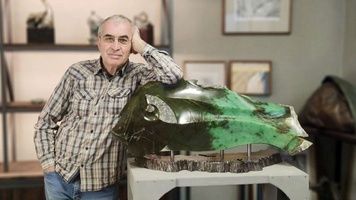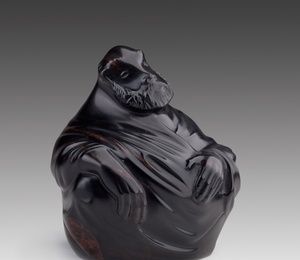Скульптор Сергей Фалькин: «Скульптура говорит на своем языке»
Скульптор Сергей Фалькин: «Скульптура говорит на своем языке»

Сергея Фалькина, работы которого хранятся в собрании Государственного Эрмитажа и в других музеях, эксперты называют основателем нового направления в камнерезной пластике. Мастер рассказывает о себе и особенностях работы с твердым цветным камнем.
— Сергей Александрович, по образованию вы журналист. По призванию — скульптор…
— Родился я не скульптором. Просто с младенчества у меня был интерес к рукоделию. Сколько себя помню, я что-то придумывал, потом старался слепить, нарисовать то, что роилось в голове. В песочном овраге строил дороги, по которым ездили машины, вылепленные мною же из пластилина. Вырезал из картона и раскрашивал солдатиков. Из катушек делал пушки и разыгрывал какое-то сражение… В школе путевкой в Артек меня наградили не за учебу, а за художества — я делал стенгазеты, рисовал, мастерил.
Мне было интересно всем этим заниматься, и это всегда присутствовало в моей жизни, хотя долгое время было чем-то побочным. Не воспринималось ни мной, ни родителями как нечто серьезное. Поэтому после школы я поступил на физико-математический факультет педагогического института. Математика мне легко давалась.
— Но математиком вы не стали…
— Однажды весной, в конце второго курса, я вдруг представил себе свое будущее: вот я окончил институт, работаю в школе, может быть даже директором… Мне стало неуютно, я понял, что это не мое, и выкинул фортель — пошел в военкомат. Это был, как мне тогда представлялось, единственный способ бросить институт и поменять свою судьбу.
Служил в Литве, в воздушно-десантных войсках, о чем не жалею. И не считаю это потерянным временем. Я занимался самообразованием, ходил в библиотеку, у меня был самый толстый формуляр в полку. Параллельно рисовал, увлекся гравюрой по дереву, окончил заочную Школу военных корреспондентов. Немножечко публиковался в военных газетах. Все это параллельно со службой.
Я тогда уже думал про литературу, про то, чтобы заниматься ею всерьез. Про изобразительное искусство — еще нет. Перед дембелем взял направление на рабфак Ленинградского университета, на факультет журналистики. Представлял, что буду изучать жизнь и параллельно заниматься литературой...
— Как вы поняли, чем хотите заниматься на самом деле?
— Когда я анализирую собственную жизнь, я вижу, что все построено на случайности. Где-то что-то произошло, я с кем-то познакомился, и это поменяло мою судьбу... Мимо каждого из нас проходят множество людей, случаи, события происходят постоянно. Но мы можем просто не заметить, не отреагировать. Или, если ты готов к этой случайности, ты ее хватаешь за хобот, и это меняет жизнь. Ты занимаешься чем-то, напрямую никак не связанным с твоими основными делами, но это меняет твой способ мышления. По чуть-чуть, понемножку…
— Например?
— Параллельно с учебой в университете я занимался в литературном объединении Александра Кушнера, посещал студию рисунка Льва Овчинникова, знакомился с разными людьми. Мне очень все это нравилось — разговоры про поэзию и искусство, литературное общение… Однажды сестра моей жены подарила мне набор инструментов, и я начал резать по дереву (мне это было не трудно, потому что я с детства любил такие занятия). Как-то показал свои работы одному знакомому из студии, и он отвел меня в мастерскую скульптора Виктора Ставницера. Я сначала просто смотрел, слушал, чему-то учился, со временем начал помогать с заказами...
Другой случай: редактор газеты, в которой я работал уже после университета, познакомил меня с заведующим редакционно-издательского отдела Эрмитажа, и в какой-то момент тот сказал, что у него есть свободная ставка...
— В Эрмитаже вы занимались оформлением каталогов?
— Да, но не только этим. Эрмитаж — своего рода моя альма-матер. Потому как объем информации, который меня захлестнул там, очень сильно на мне сказался. Когда ты каждый день идешь на работу мимо античных ваз, мимо Рембрандта, проходишь подвалом Зимнего дворца, ты не можешь не впитывать все это. Сама возможность к этому прикоснуться бесценна, а я мог еще задавать свои глупые вопросы хранителям, реставраторам. И они мне отвечали, объясняли, рассказывали. Именно это дало мне основу, фундамент. Я могу не помнить какие-то даты, день рождения художника, но я знаю ту эпоху, то время, то состояние, в котором он находился, как происходило его движение, трансформация. Я понимаю эти основные пласты. Без Эрмитажа у меня этого понимания, наверное, не было бы. Или путь был бы совсем длинный, другой.
Ну и параллельно у меня шла жизнь в современности — работа со Ставницером в скульптуре, в дереве… Это был такой этап формирования и становления, зарождения каких-то мыслей и ощущений. И это все — случайности.
— Вы принимали участие в воссоздании Янтарной комнаты в Царском Селе…
— Да, я год проработал в Царскосельских реставрационных мастерских. К этому моменту у меня уже был опыт резьбы по дереву. Перейти на другой материал было несложно. И это был очень полезный опыт.
— Сейчас вы работаете в основном в камне. Чем привлек вас этот материал?
— Твердый цветной камень тяготеет к декоративно-прикладному искусству, в нем заложено это издревле, от древних греков. Из камня делают шкатулки, вазы, настольные фигурки, которые украшают быт и сами по себе не несут какой-то эмоциональной, смысловой нагрузки. А меня всегда интересовала скульптура, цвет в скульптуре и камень как материал для скульптуры. Я все время про это думал и подкрадывался постепенно, потому что мирового опыта работы с камнем как материалом для скульптуры у человечества практически нет. Между тем разнообразие камня потрясает — цвет, структура, выразительные возможности…
— В чем особенность работы с камнем?
— Что такое скульптура? Это авторское отношение к миру, выраженное через объем, через материал. В чем суть камня? Его в определенных условиях родила природа. Это плод. Такой же плод, как яблоко. Только растет в других условиях. Ты должен считаться с тем, каким этот плод рожден. Я работаю под камень, с камнем. И здесь нельзя сказать, что первично — моя мысль или камень. Поэтому я говорю, что камень — мой соавтор. Он где-то подсказывает, где-то противится, где-то преподносит сюрпризы. Да, я вылепил модель под камень, что-то предположил, но потом все равно начинается импровизация. Ты все равно работаешь не механически… Это как перевод с японского на русский. Ты знаешь один язык и знаешь второй, но смысловые оттенки, ритм фразы, порядок слов — все разное. Ты должен сделать не дословный перевод, а передать настроение, состояние. Ты понимаешь материал и переводишь его суть на язык пластики. Ты прислушиваешься к нему, считываешь его подсказки, учитываешь моменты, которые в нем заложены, — рисунок, прозрачность, фактуру...
— Чем бронза как материал для скульптуры отличается от камня?
— Есть понятия синтетического и аналитического искусства. Камень или дерево ты анализируешь, вгрызаясь в него, разбирая на части, вступая в диалог. Камень — это заданные рамки, в которых ты находишься.
Глина, пластилин, бронза — синтетическое искусство. Ты синтезируешь, набираешь, наращиваешь форму, исходя из своей идеи. Ты диктуешь материалу образ, ритм, линию. Он подчиняется.
— Вас иногда называют продолжателем дела Фаберже. Насколько это верно?
— Фаберже в некотором смысле является для меня учителем. Чтобы понять материал и его возможности, нужно было пройти этот путь чисто технического, технологического его освоения. В этом плане Фаберже — хорошая школа. В свое время в Эдинбурге я попал на выставку Фаберже из собрания королевской семьи и увидел знаменитую ветку березы, с почками и листьями. Эти листья обработаны удивительно, у них муаровая фактура, и этого не увидишь на фотографии. Вернувшись домой, я начал думать, как это можно сделать в нефрите, как достичь этого эффекта. И вычислил, мы начали это повторять в мастерской.
Но я не продолжаю дело Фаберже. Продолжатели — уральские мастера, усвоившие его опыт и шагнувшие далеко вперед. Появились новые материалы, алмазные инструменты, другие технические возможности, и они все это используют. Они работают виртуозно, их изделия вызывают удивление, но не эмоции, не то, что называется искушением. У меня другие задачи. Я позиционирую себя как скульптора, работающего в этом материале, а не как камнереза. Камнерез — это ремесло, человек, умеющий резать камень, перевести набросок, модель на язык камня. Но это не сочинитель, не автор. В его работе нет ни метафоры, ни образа, ни авторского отношения… Всего того, что я стараюсь вложить в свои скульптуры.
— Темы ваших работ очень разнообразны. Мифы, библейские сюжеты, анималистика… Как они рождаются?
— Темы вторичны. Это не самое главное. Можно открыть словарь Ожегова — там полный список тем. На любой странице вслепую тыкаешь пальцем и попадаешь на какое-то слово. Предположим, «убегать». И у тебя сразу выстраивается ассоциативный ряд — заяц или человек-вор, или еще что-то. Слово ушло, осталось состояние. Вырывающийся из… Исчезающий от… И ты переводишь это на пластический язык, видишь, как оно перетекает через твои ощущения, подкрепляется словами, которые уточняют соотношение масс, объемов...
— Вы говорите о случайностях, но совершенно очевидно, что вас ведут не только они, но и ваш собственный азарт, жизненная сила…
— У художника есть три точки, которые делают его художником.
Первая — это подкорка, наша кладовая, копилка впечатлений. Самое сложное для человека — видеть. Ты смотришь на снег и видишь, что он белый. На самом деле это не так. Он не белый, не гладкий, не однородный, в нем множество оттенков, нюансов. По большому счету мы это видим, но не фиксируем. Взгляд прошел, подкорка все сохранила, но между подкоркой и осознанным видением — железобетонная стенка. У художника ее быть не должно.
Вторая точка — точка восторга, солнечное сплетение. Если она не заросла, ты готов к удивлению, к восторгу. Без этого не возникнет интерес, желание творить. Третья находится внизу, у основания позвоночника — это точка созидания, энергии. Если она активна, у тебя достаточно сил, чтобы перевернуть мир. На этих трех точках рождается и существует художник.
